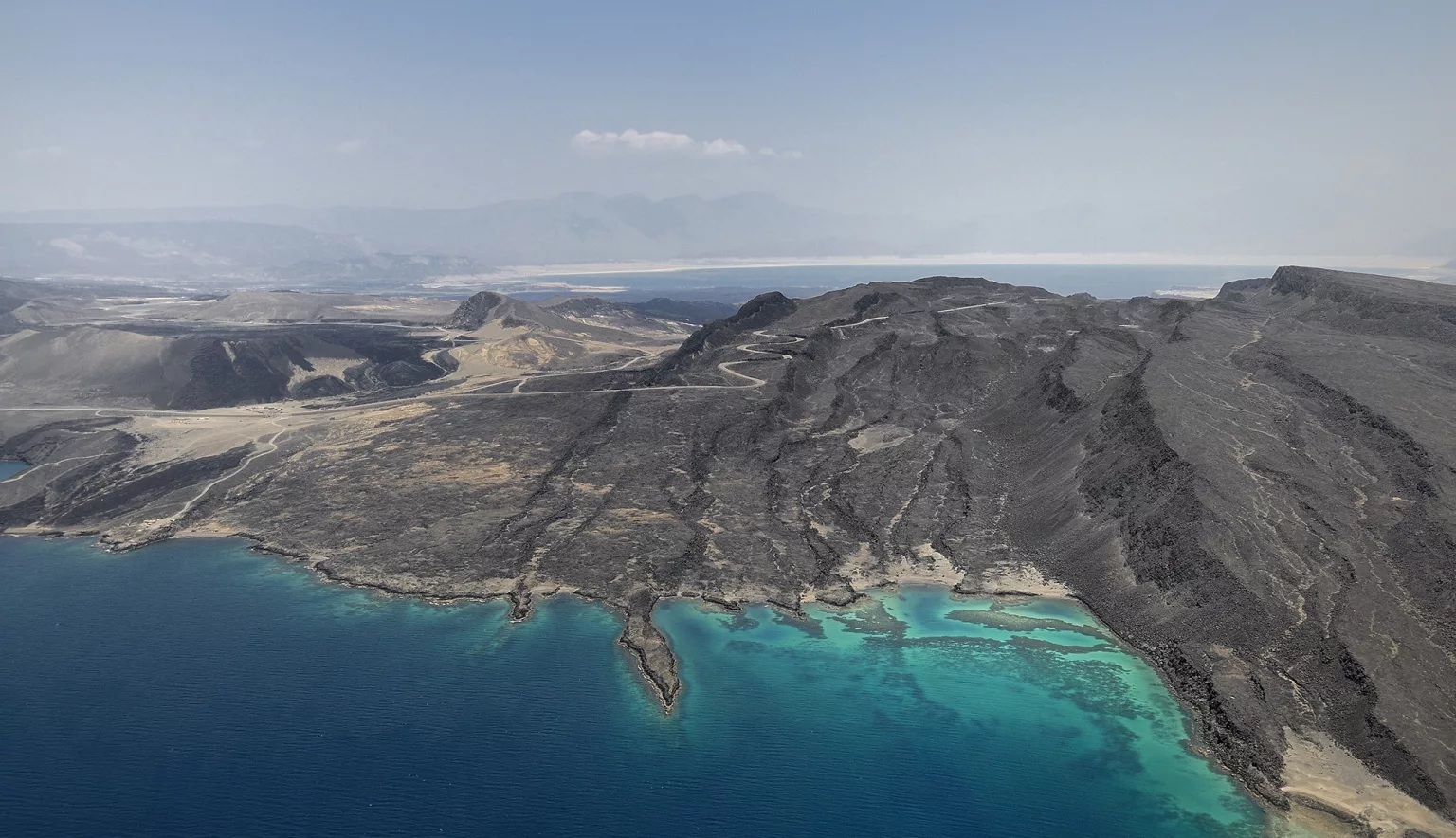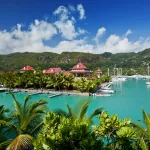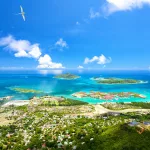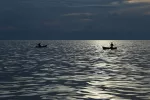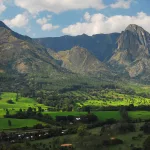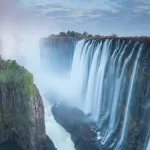A country referred to as the Iceland of Africa, Djibouti is like no other on the continent, home to one of the world’s most fascinating landscapes.
DJIBOUTI
Dwarfed by Ethiopia to the north, west, south and everywhere in between, Djibouti is renowned as being one of Africa’s smallest countries, yet equally one of its most fascinating. Situated along the seams of the Afar Triple Junction where three of the world’s tectonic plates meet, the East African nation is a mashup of salt lakes, volcanic formations, expansive canyons and ceaseless plains, topped off by the stunning blue coastlines of the Gulf of Aden. Often described as the Iceland of Africa, Djibouti is somewhat a continental anomaly compared to many of its neighbours and remains relatively devoid of the waves of tourists to match. This is not to say that the country is unwelcoming, however.
It’s not uncommon for travellers to be invited into locals’ homes for a pot of tea, while ecotravel and activities such as hiking and diving are becoming increasingly popular. Further, other than pickpockets, crime rates affecting travellers remain low comparative to many other nations.Djibouti’s stunning landscapes aside, Djibouti City remains the nation’s epicentre. Home to well over half of the country’s entire population, it is here that modernisation, progression and business travel are thriving, the capital dotted with high end hotels and varied restaurants – a far cry from its more remote corners.
THE BUSINESS END
Known as the ‘Pearl of the Gulf of Tadjoura’, Djibouti City is the main driver of the nation’s economy. City port, for example, acts as the primary trade hub for not only Djibouti itself but equally for imports and exports to and from landlocked Ethiopia – a country 50 times its size. Combined with the coast of Yemen being situated just 800 kilometres from Djibouti as the crow flies, this makeup has dictated that the country’s economy remains largely service driven, providing key transit and logistics solutions to the region while also acting as an international transhipment and refuelling station.
Owed to these tailwinds, accompanied by growing prosperity in many alternative industries such as construction, Djibouti saw a GDP growth rate of 6.7 percent through 2018. Further, incomes from tourism are both on the rise and becoming increasingly widespread. Key landmarks and historic buildings are traditionally found in populated urban areas, yet the nation’s rising ecotourism is being shared amongst the country’s more rural regions.
TOURISM INSIGHTS: DJIBOUTI NATIONAL TOURISM OFFICE
One organisation promoting national tourism is the Djibouti National Tourism Office, headed up by Osman Abdi as the Director-General. Formed in 1969, the office has sought to develop the sector by supporting a number of industry-centric initiatives. Speaking with Abdi, we discover how Djibouti has become increasingly prominent on the international destination scene as a result.
Q&A WITH OSMAN ABDI, DIRECTOR-GENERAL, DJIBOUTI NATIONAL TOURISM OFFICE
How would you say Djibouti has developed in recent years as a business travel hub and what are the key reasons behind its growing appeal?
Osman Abdi (OA): Djibouti has considerable potential due to its geographical position. Located at the crossroads between East Africa, the Arabic Peninsula, the Asian continent and Europe, Djibouti serves as a gateway to the Suez Canal. In terms of business, Djibouti was ranked 99th in the Doing Business Report 2019, gaining 55 places compared to the previous year. This highlights the country’s positive economic climate and that Djibouti offers great investment opportunities, particularly in tourism and hospitality via the National Investment Promotion Agency which gives special incentives. Further, the government has invested heavily in domestic infrastructure such as the reboot of Air Djibouti passenger flights in 2016, the inauguration of the new Addis-Ababa-Djibouti railway, the ongoing construction of two new international airports and the modernisation of the current airport.
Why, in your opinion, should someone visit Djibouti?
(OA): Djibouti is one of the most fascinating destinations of Africa. As a trading post where different cultures have historically collided, Djibouti is home to a heady mix of African, Arabic and French influences, giving it an exotic atmosphere. The country offers diversified products, from diving to fishing, geological exploration to bird watching, and trekking to excursions. In addition, Djibouti was named as the “World Capital of Tourism and Culture” in 2018 by the European Council of Tourism and Trade and was also recommended by Lonely Planet as the fourth best destination.
Are there any specific attractions, landmarks or places to eat and drink that you would recommend?
(OA): Yes, the Republic of Djibouti has numerous sites such as Lake Assal, one of the most unique places in Africa. This meets an even rarer geological curiosity – the famous open-air fault where one can observe the meeting of two tectonic plates. Also, you’ll never forget your first glimpse of Lake Abbé. The scenery is sensational, and the plain is dotted with hundreds of limestone chimneys, some standing as high as 50 metres, often described as ‘a slice of moon on the crust of the earth’. Djibouti is equally one of the few places to swim with whale sharks, while other popular tourist attractions include the Ardoukoba volcano and the forest of Balho.
What trends are transforming the tourism industry in Djibouti at present?
(OA): In 2018, Djibouti initiated a new strategy for sustainable tourism to boost the industry through ecotourism and environmentally sustainable solutions. It is recommended that industry operators now plan their priorities around socially and environmentally responsible tourism while creating income-generating activities for local communities. In the way of perseveration, the National Tourism Office in collaboration with the Ministry of Environment implemented a plan to make terrestrial and marine areas protected. As part of Djibouti Vision 2035, the National Tourism Office has expressed that it hopes to attract 500,000 visitors by 2030.
Are there any plans or projects in the pipeline that you wish to highlight?
(OA): The National Tourism office of Djibouti is planning to increase its participation at tourism fairs and launched a campaign under the slogan ‘Djibouti – a destination in the heart of adventures’. We’re working to attract more tourists from Ethiopia which appears a significant potential market for Djibouti, cooperating with the Ethiopian Tourism Organization to promote joint packages. Further, the construction of new hotels is planned, as is the transformation of the old port of Djibouti into a cruise port.
OUTLOOK RECOMMENDS
DRIVE:
EAT:
STAY:
NATIONAL PARKS:
OUT AND ABOUT
While Djibouti City itself offers a mixture of westernised comforts and cultural phenomena, whether it be beautiful beaches or historic buildings, many of the country’s true wonders can be found outside of the capital. This in mind, it is highly recommended to set aside some time for travel around the nation during your visit. From shimmering lakes to the Goda Mountains, there are a range of natural marvels present, the most famous being Lac Assal. Renowned as the third lowest point on the earth’s surface at 155 metres below sea level, this stunning crater lake can be found right in the heart of the country, home to waters that are 10 times saltier than the sea.
The islands of Moucha and Maskali are also worth a visit, both reachable via a 45-minute boat ride from the port of Djibouti town. The waters surrounding these enclaves are idyllic for divers, providing the opportunity to see manta rays, sharks and other exotic marine life. Tadjoura Bay is equally recommended for not only its fantastic beaches but also its diverse aquatic flora and fauna, famed for unrivalled snorkelling and fascinating, relatively untouched reefs. Coastal fishing, as you might expect, is a key life source for the country. As such, both markets and restaurants can be found in an abundance, offering the chance to taste many local delicacies such as grilled Yemeni fish.
GETTING THERE AND AROUND
Prior to French colonialism, owed to Djibouti’s history as a nomadic nation, the only real method of transport was via camel. Times have moved on since then, however, with the country home to a thriving international transportation centre – the Djibouti-Ambouli International Airport. Situated roughly six kilometres from the centre of Djibouti City, it is well-equipped to serve hundreds of thousands of passengers a year and will be the primary method of entrance into the country for most.
From the airport, the easiest method of transport is taxi. All state owned and easy to spot with their bright green paint, these are easily found in and around the airport and the countries other urban areas. If you find a driver that you like, however, then it’s relatively common practice to offer them repeat business. Just make sure that you always negotiate and agree a price before hopping in. Other ways of navigating the country include water taxis such as the daily ferry services available to and from Obock, Tadjoura, Djibouti City, Moucha and Maskali. Land-borne public transport is less reliable. No rail services are in operation and buses and minibuses, being privately owned, aren’t timetabled. Drivers don’t often speak English either, but fares can be as low as $0.25, making this a cheap and relatively attractive option of travel.

